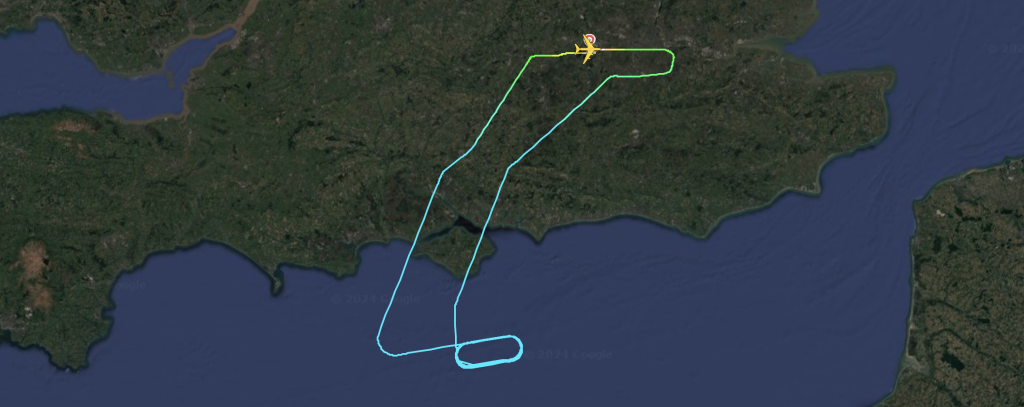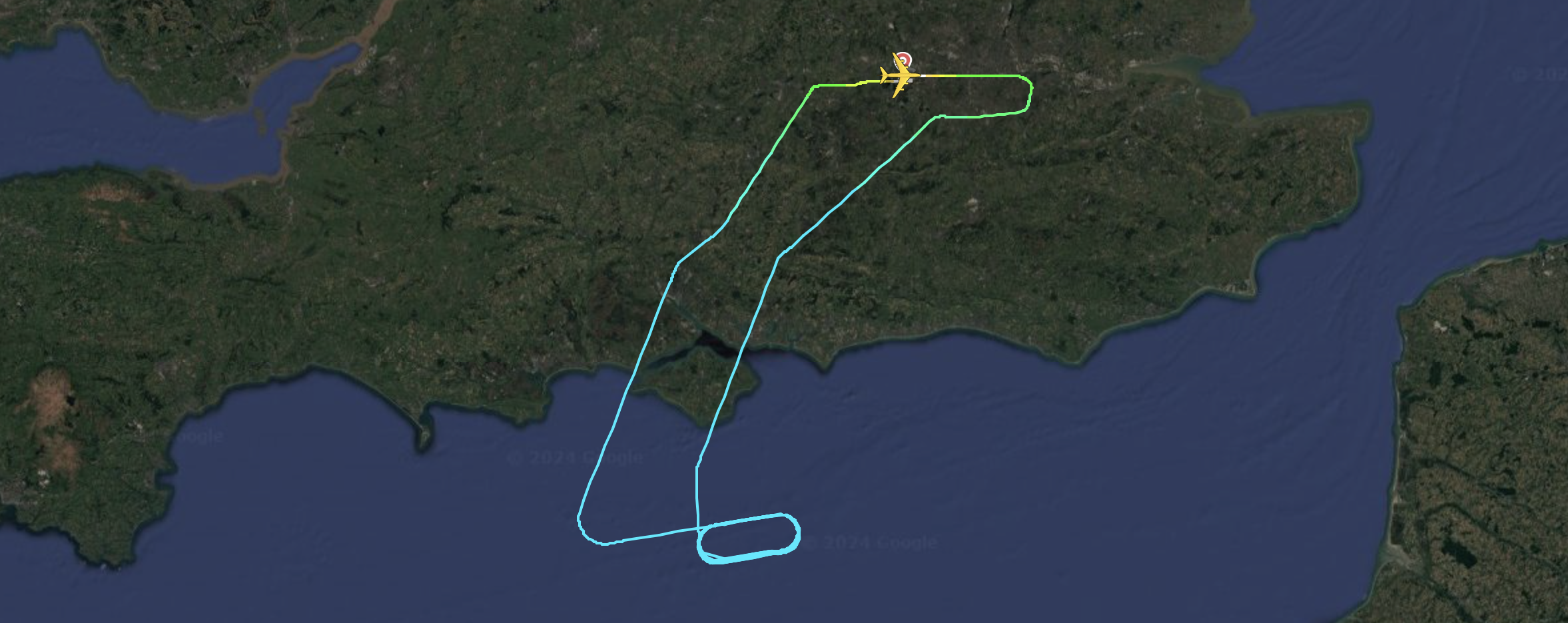On November 6, 2024, British Airways Flight BA207, an Airbus A380, departed London Heathrow bound for Miami. Shortly after takeoff, the aircraft encountered an engine issue due to an oil leak, prompting the crew to shut down one of the four engines and make the decision to return to London. However, with fuel tanks filled for a long transatlantic journey, the aircraft was significantly above its maximum landing weight. To ensure a safe return, the crew entered a holding pattern over the English Channel, began fuel dumping, and finally returned to Heathrow. The aircraft remained in this holding pattern for not less than 2h45!


This incident provides a valuable opportunity to delve into the complex topic of fuel dumping, a lesser-known yet critical safety measure in aviation. Let’s explore why fuel dumping is sometimes necessary, how it works, and what happens to the fuel once it’s dumped from the aircraft’s tanks.
Maximum Take-Off Weight vs. Maximum Landing Weight
All commercial aircraft are engineered with two key weight limits: maximum take-off weight (MTOW) and maximum landing weight (MLW). The MTOW is the highest weight at which an aircraft can safely take off, accounting for fuel, passengers, cargo, and baggage. For long-haul flights, such as the one from London to Miami, the aircraft often departs near MTOW, carrying enough fuel for the journey plus reserves.
On the other hand, MLW is the maximum weight at which an aircraft can safely land without risking structural strain. Landing above MLW could lead to excessive stress on the airframe, landing gear, and braking systems. For this reason, if an aircraft needs to land shortly after takeoff and hasn’t had enough time to burn off fuel, it may need to reduce weight quickly, which is where fuel dumping becomes a practical solution.
What Happens if an Aircraft Must Land Above Maximum Landing Weight?
In rare, critical emergencies—such as an onboard fire or severe technical failure—an immediate landing might be required, even if the aircraft exceeds MLW. When this occurs, pilots may take additional steps to lessen the strain on the airframe, such as using a longer approach to reduce landing speed and extending flaps and slats to increase lift and drag.
While manufacturers design modern aircraft to withstand overweight landings in extreme situations, landing above MLW often requires thorough post-flight inspections to check for potential damage. If possible, however, fuel dumping is preferred over landing above MLW, as it minimizes the risk of damage and the need for repairs.
Why Dump Fuel Instead of Simply Burning It?
A common question is why an aircraft would dump fuel instead of burning it off. The answer largely depends on time constraints. In BA207’s case, the crew needed to reduce weight “quickly”, as burning the excess fuel would have extended the flight by several hours.
Fuel dumping provides a faster and more efficient way to reduce weight, allowing the aircraft to land safely without too much delay. In BA207’s case, the Airbus A380 entered a holding pattern at 13,000 feet above the English Channel and began dumping fuel, gradually reaching a weight suitable for landing. Holding over a body of water like the Channel, rather than populated areas, ensures minimal environmental and public impact.
Unfortunately for the passengers, fuel dumping happens at a limited rate and in this case, the fuel dumping phase did last for close to three hours.
What Happens to the Dumped Fuel?
When fuel is released from an aircraft, it disperses into tiny droplets and evaporates in the atmosphere, typically before it reaches the ground. This process occurs more effectively at higher altitudes, where lower air pressure and cooler temperatures accelerate evaporation. In BA207’s situation, the dumping took place at 13,000 feet, which is typical for fuel dumping; some fuel may descend, but typically only trace amounts reach the surface.
To mitigate impact further, pilots and air traffic controllers choose holding patterns over less populated areas, and factors like wind speed, temperature, and humidity are considered to maximize evaporation. In this case, dumping over the English Channel further minimized potential environmental impact, as any residual fuel would be dispersed over water rather than land.
Flight Level Considerations: Dumping at FL130
In some situations, the crew may opt to release fuel while maintaining a slight climb, which helps avoid flying through any remaining fuel cloud from a previous hold. The Airbus A380’s holding pattern over the Channel was at FL130 (13,000 feet).
Maintaining separation from fuel remnants helps protect the engines and other sensitive equipment from fuel ingestion, and in BA207’s case, staying at FL130 allowed the crew to release fuel at a safe altitude without impacting air traffic or re-entering the fuel cloud.
Fuel Dumping Systems: Why Some Aircraft Have Them and Others Don’t
Fuel dumping capabilities are more common in larger, long-haul aircraft like the Airbus A380, which regularly operate at weights close to MTOW and may need to shed significant weight rapidly. On the A380, the fuel dumping system is sophisticated, allowing pilots to control the rate and quantity of fuel released to reach an appropriate landing weight.
In contrast, most narrow-body aircraft, such as the Airbus A320 or Boeing 737, lack fuel dumping systems. These aircraft are primarily used for shorter routes, and even if they’re full on fuel, they’re often able to land safely at or near MTOW if necessary. For these aircraft, fuel management on shorter flights rarely necessitates dumping systems, and alternatives like fuel burning or diversions to nearby airports are generally sufficient.
As an example, the maximum take-of weight of an A380 is 560’000 kgs and its maximum landing weight is 319’000 kgs, a difference of 169’000kgs. To put it differently, the maximum landing weight is ca. 57% of the maximum take-off weight.
To compare, an A320 has a maximum take-off weight of 77’000 kgs and a maximum langing weight of 64’500 kgs, which is ca. 84%, explaining why a fuel dumping system is not required on the A320.
Environmental Considerations in Fuel Dumping
Although fuel dumping is rare and conducted responsibly, it does carry some environmental considerations. Most fuel dissipates before reaching the ground, but trace amounts can occasionally reach lower altitudes. Authorities such as the FAA and ICAO set guidelines for when and where fuel dumping can occur, helping to minimize environmental impact.
Pilots, air traffic controllers and airlines follow these guidelines carefully, performing fuel dumps only in necessary situations and ideally over water or unpopulated areas. While the fuel typically evaporates, the regulatory oversight ensures that procedures minimize potential effects on the environment.
Communication and Coordination with Air Traffic Control
Coordination with Air Traffic Control (ATC) is crucial during a fuel dump. The crew must inform ATC of their location, altitude, and planned duration, and ATC works to ensure the aircraft maintains a safe distance from other air traffic. ATC may also reroute other aircraft temporarily to keep them clear of the dumping area.
For BA207, ATC guided the A380 into a holding pattern over the English Channel, an optimal location for fuel dumping. This careful communication and planning help prevent disruption in busy airspace and ensures safety for both the crew and other aircraft.
Final Thoughts
The fuel dumping procedure conducted by BA207 on November 6th highlights the critical safety measures in place to handle unexpected situations. While the idea of releasing fuel mid-air may seem surprising to some, it’s a highly regulated, carefully coordinated procedure that prioritizes passenger safety and minimizes environmental impact.
By exploring the reasons behind fuel dumping, such as weight limits, fuel dispersion, and the environmental aspects, passengers and the public can better understand the safety practices that underpin modern aviation. The BA207 incident is a testament to the training and precision of aviation professionals, who work tirelessly to ensure safety at every stage of flight.

Leave a Reply